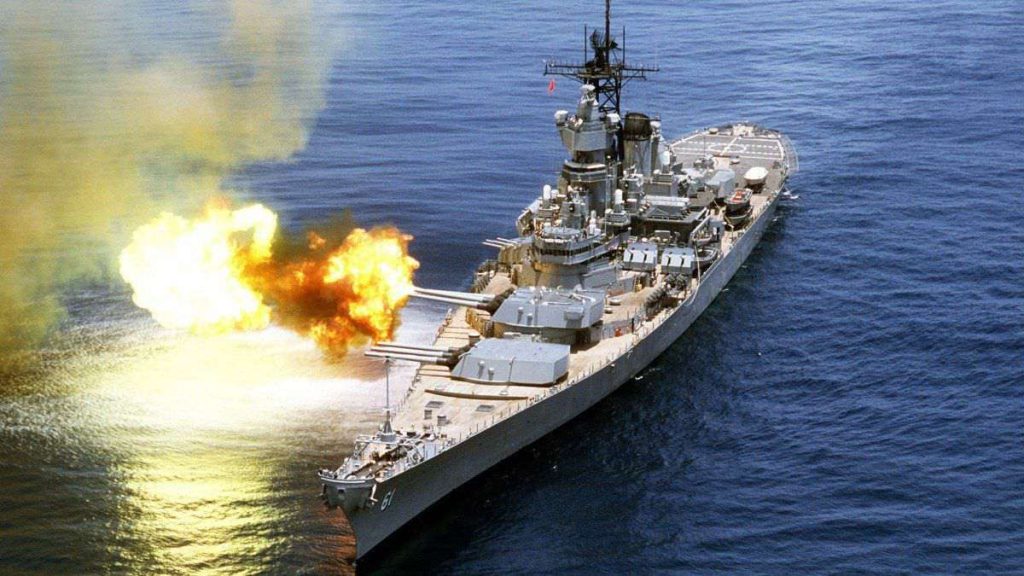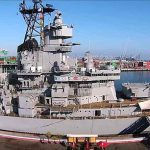A full broadside salvo fired by battleship is one of the most fearsome and destructive forces in military affairs. Battleships of the 20th century mounted up to twelve guns that fired shells packing over a ton of high explosives. Though outmoded by guided missiles, such broadsides were incredible.
Battleship Broadsides: Now But a Memory
No battleships are currently serving with any navy in the world. Considered to be a relic of the pre-World War II arms races and obsolete in the face of aircraft carriersand long range strike aircraft (to say nothing of submarines, guided missiles, and nuclear weapons), all surviving battleships now in existence were built in the 1940’s and last used in the early 1990’s to bombard Iraq with cruise missiles and diversionary bombardments.
The obsolescence of the battleship would have come as a shock to naval architects and strategists of the early 20th century, who staked their careers and their nations on building as many of the most powerful battleships as possible. For decades newspapers and smoke filled rooms hosted discussions of the power of some other country’s newest battleships and above all, how big their guns were.
Even arms control treaties of the 1920s and 1930s focused on the size of a proposed battleship’s guns. The striking power of such vessels was bound to the size and number of the guns they carried, which in turn determined the weight of the broadside they could bring to bear on an opponent. A battleship firing broadside salvos at an enemy was the epic image of naval combat throughout the 1900s to the 1940s, and engagements like the Battle of Jutland were held to be won or lost based on the number of battleships and, to a lesser extent, battlecruisers that had been sunk.
So with such a strong emphasis on broadside strength and gun barrel sizes throughout a pivotal half century of European history, contemporary analysts can perhaps be forgiven for their inability to realize that battleships would no longer be threatened primarily by plunging fire from opposing battleships, but by aircraft bearing torpedoes and one day guided missiles. Indeed the battleship became effectively obsolete faster than anyone could have reasonably predicted, and by the end of World War II the battleship broadside was already becoming a legacy of past glory.
The Battleship Arms Races: My Gun is Bigger!
The launch of the HMS Dreadnought around 1900 began an epic race between the major world powers to see which navy could deploy the most battleships armed with the biggest guns. During this period there was a revolution in armament and protection that set Dreadnought apart from previous capital ship classes. No more would heavy guns be scattered around the ship, perhaps in barbettes arrayed in the hull above the waterline. Guns would now be 10″ in diameter or greater, and be set in turrets containing two, three, or even four guns. These in turn would be placed approximately along the centerline of the battleship to ensure a stable and predictable firing platform.
This arrangement meant that a battleship’s broadside could be more powerful than ever before, and that guns could fire at high angles to achieve ever steeper penetration angles more likely to break through a target’s armor. It also began an era where the battleship firing broadside salvos of most or all its main armament at once would become the most vivid expression of naval might. And an arms race ensued as well, with continual innovations and one-upping the best designs of other navies.
Guns rapidly increased in diameter and length, and with these increases came boosts in the displacement of battleships, their length, and the amount of explosive power they could deliver onto a target at any given time. 10″ guns gave way to 11″, 12″, and 13″ guns. By the time of the First World War 14″ and 15″ guns were common and the battleships that mounted them were often called super-dreadnoughts. Many of the battleships and battlecruisers that tore into one another at Jutland in World War I carried such heavy guns, and development of even bigger guns did not cease during the Interwar period.
Indeed, by the Second World War 16″ guns were becoming standard in the United States Navy, and updated 15″ guns were installed on some of the biggest warships of the time, including the KMS Bismarck and KMS Tirpitz and the proposed Alsace Class battleship design put together in France. Of course the Japanese hold the record for the biggest naval guns deployed on a warship: their Yamato Class battleships were equipped with nine 18″ guns – unheard of at the time.
Inside the Battleship Turret: A Dangerous Battle Station
To accommodate the ever-larger guns mounted on battleships, the size of the turrets that housed them had to increase as well. And so the crews whose job it was to load, clean, and fire the guns grew in size and importance. The loss of a turret could be catastrophic for a battleship, as evidenced by the HMS Prince of Wales’ poor performance in the Battle of the Denmark Strait against the KMS Bismarck and the KMS Prinz Eugen.
The conditions inside a battleship gun turret were inevitably crowded no matter how wide the turrets themselves became. Such turrets were incredibly heavy, and a major percentage of a given battleship’s weight was given over to the turrets. They were heavily armored citadels intended to be resilient to all but the most powerful weapon hits. They were artificially lit and quite dangerous – even aside from being the primary target of an attack on the battleship, having hundreds of pounds of explosive propellant and heavy metal shells filled with high explosives in a confined space is inherently dangerous.
Indeed, one of the dangers in a battleship turret was that of accidental explosions. Even in the late twentieth century, when the last battleships were coming to the end of their life, an explosion in the turret of the USS Iowa took the lives of the entire number two turret crew of 47 sailors in 1989. Throughout the history of the battleship, turret explosions due to mishandled powder or shells or even enemy action resulted in the death of numerous sailors who had to work in extremely close quarters with highly explosive compounds. The spectacular broadside of a battleship firing all its guns came at high cost to sailors assigned to the turret crews.
The Power of the Battleship Broadside
A battleship firing a broadside at a target is an incredible sight, and a pyrophile’s ultimate fantasy. For those at the other end of the guns the sight is equally as incredible, but more akin to something out of a nightmare.
A standard 16″ shell fired from one of the US Iowa Class battleships can weigh around a ton – around 2000 lbs. These same battleships mounted nine of these guns as their standard armament, three guns each in three turrets located fore and aft of the main superstructure of the battleships in the class. When bombarding a target to port or starboard this means that nine tons of powerful explosives can be almost simultaneously fired at an opponent. When utilizing fire for effect and time on target techniques, guided by the fire control directors that have been standard on battleships since before the Second World War, this means that at times several salvos can strike a target more than 20 miles away from the battleship.
Imagine being caught in such a hail of fire. Two thousand pounds of explosive force is more than that present in most bombs dropped from combat aircraft. And no aircraft save perhaps a heavy bomber can put nine bombs of that size on a target simultaneously. Under a bombardment like that the victims would hear the incoming shells, a piercing scream familiar to anyone who has been under fire or trained using the proper simulation equipment. Nine of them would magnify that sound, and be deafening. And when they exploded, it would be as if the earth itself were tearing asunder. The ground would shake, the air would compress – it would feel as if innumerable sledgehamers had struck the body. The air would be torn apart by shell splinters and other shrapnel, and wave after wave of heat would wash over.
Battleships throughout history could keep up such a bombardment for several minutes at the very least, and possibly for hours. Indeed, their huge guns could fire until the men inside the battleshup gun turrets ran out of powder and ammunition. The destructive power of a battleship bombardment was felt by sailors and soldiers throughout the Pacific Theater in World War II, as well as the beaches of Normandy on D-Day.
The Battleship’s Nemisis: Air Power
Of course, if the battleship is sent to the bottom of the ocean before it ever comes in range of a target then the size and number of its guns is utterly irrelevant. And this simple fact is what has doomed the battleship to obsolescence, and means that the few surviving battleships will likely be kept as museum ships or sunk as targets.
The fate of the Yamato and Musashi in 1944 and 1945 proved that the day of the battleship had come and gone. Both were destroyed by airpower, not by other battleships. The Bismarck too met her destiny primarily due to aircraft, which tracked her down and put a torpedo into her steering gear, allowing her to be intercepted by a vastly superior force of battleships. US Battleships were struck time and time again by bombs, torpedoes, and kamikazes and they were lucky: Japanese planes destroyed the HMS Prince of Wales with ease. And of course there is Pearl Harbor – a permanent reminder of the dangers of preparing to fight the last war and ignoring the advance of technology.
Nowadays battleships are oddities, even in the US Naval Reserve. Their main guns were last fired in anger during the 1991 Gulf War, and even there they were primarily used as cruise missile launch platforms. With navies around the world deploying heavy sea skimming cruise missiles and even China joining the aircraft carrier club the battleship has likely seen its last engagement.
But history will remember the spectacular vessel and its lethal broadside of some of the heaviest guns ever built.
Battleship Images








Comments are closed